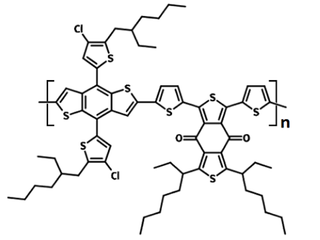PBDB-T-2Cl (PM7)
CAS Number 2239295-71-5
Luminosyn™ Polymers, Materials, OPV Polymers, Semiconducting PolymersPBDB-T-2Cl, used to achieve efficiencies exceeding 12%
High quality polymer available for fast, secure dispatch
Specifications | MSDS | Literature and Reviews | Technical Support
PBDB-T-2Cl (CAS number 2239295-71-5), also known as PM7, is part of the PBDB-T polymer family. It has a high OPV device performance, with reported efficiencies exceeding 12%. PSCs based on PBDB-T-2Cl as the donor and ITIC-2F as the acceptor have achieved a power conversion efficiency (PCE) of over 14% [2].
Compared to PBDB-T-2F, PBDB-T-2Cl showed slightly lower calculated HOMO levels. Although fluorine has greater electronegativity, it is believed that electron density can be delocalized more effectively to the chlorine atom than the fluorine atom on the BDT (benzodithiophene) backbone unit, resulting in a deeper HOMO energy level.
For 5 – 10 grams order quantity, the lead time is 4 – 6 weeks.
PBDB-T-2Cl (PM7) from Ossila was used in the high-impact paper (IF 9.229), Following In Situ the Evolution of Morphology and Optical Properties during Printing of Thin Films for Application in Non-Fullerene Acceptor Based Organic Solar Cells, K. Wienhold et al., ACS Appl. Mater. Interfaces, 12, 36, 40381–40392 (2020); DOI: 10.1021/acsami.0c12390; and paper (IF 29.37), Design Rules for Polymer Blends with High Thermoelectric Performance, O. Zapata-Arteaga et al., Adv. Energy Mater., 12, 2104076 (2022); DOI: 10.1002/aenm.202104076.
The Luminosyn™ Range
General Information
| Full name | Poly[(2,6-(4,8-bis(5-(2-ethylhexyl)-4-chlorothiophen-2-yl)-benzo[1,2-b:4,5-b’]dithiophene))-alt-(5,5-(1’,3’-di-2-thienyl)-5’,7’-bis(2-ethylhexyl)benzo[1’,2’-c:4’,5’-c’]dithiophene-4,8-dione))] |
|---|---|
| Synonyms | PM7, PCE14, PBDB-T-Cl |
| Chemical formula | (C68H76Cl2O2S8)n |
| CAS number | 2239295-71-5 |
| HOMO / LUMO | HOMO = -5.52 eV, LUMO = -3.57 eV [1] |
| Soluble in | Chloroform, chlorobenzene and dichlorobenzene |
| Recommended Processing Solvents at 10mg/ml | Chloroform |
| Classification / Family | Organic semiconducting materials, Medium bandgap polymers, Organic photovoltaics, Polymer solar cells, Perovskite solar cells, Hole-transport layer materials, NF-PSCs, All-polymer solar cells (all-PSCs). |
Batch details
| Batch | Mw | Mn | PDI | Stock Info |
|---|---|---|---|---|
| M2134A2 | 139,135 | 67,261 | 2.07 | In Stock |
Previous Batch Details
| Batch | Mw | Mn | PDI | Stock Info |
|---|---|---|---|---|
| M2134A1 | 77,337 | 34,151 | 2.26 | Discontinued |
Chemical Structure

Device Structure(s)
The device structure of the certified device was:
ITO / ZnO (30 nm) / PBDB-T-2Cl:ITIC-2F (100 nm) / MoO3 (10 nm) / Al (100 nm)
PBDB-T:ITIC-2F solution details:
- Blend ratio: 1:1
- Concentration: 20 mg/ml
- Solvent: Chlorobenzene
- Additive: 1% 1,8-Diiodooctane
Record PCEs of 18.07% was achieved by using mixed PBDB-T-2Cl (PM7) and PBDB-T-2F (PM6) as the donors and mixed non-fullerene Y6 and fullerene PC71BM as the acceptors with the following structure.
Device structure: ITO/PEDOT:PSS AI 4083/PM6:PM7:Y6:PC71BM/PFNDI-Br/Ag [2]
| Thickness (nm) | VOC (V) | JSC (mA cm-2) | FF (%) | PCE (%) |
|---|---|---|---|---|
| 120 | 0.859 | 26.55 | 79.23 | 18.07 |
MSDS Documentation
Literature and Reviews
- Chlorine substituted 2D-conjugated polymer for high-performance polymer solar cells with 13.1% efficiency via toluene processing, Q. Fan et al., Nano Energy 48, 413–420 (2018); doi: 10.1016/j.nanoen.2018.04.002.
- Single-layered organic photovoltaics with double cascading charge transport pathways: 18% efficiencies, Nat Commun., 12, 309 (2021); DOI: 10.1038/s41467-020-20580-8.
- Over 14% Efficiency in Polymer Solar Cells Enabled by a Chlorinated Polymer Donor, S. Zhang et al., Adv. Mater., 30, 1800868 (2018); DOI: 10.1002/adma.201800868.
